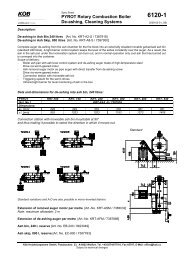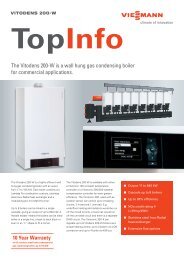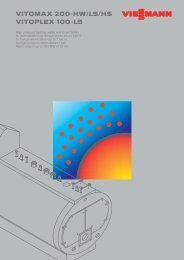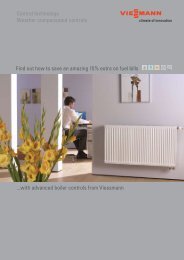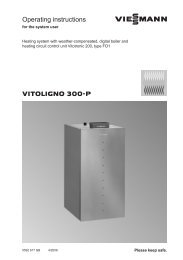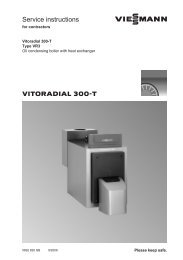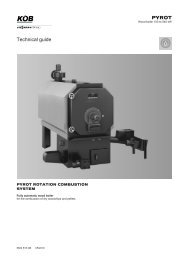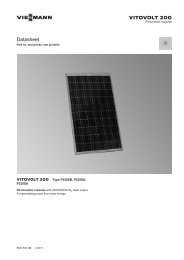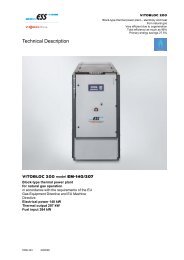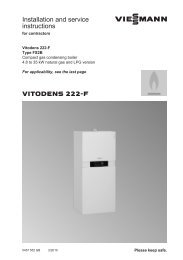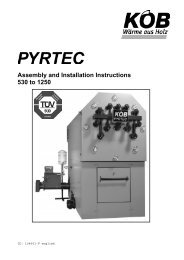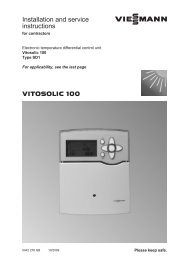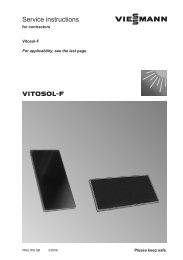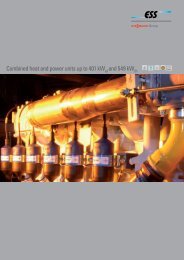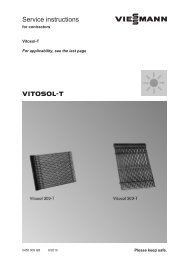VITOCELL 300 B Installation instructions - Viessmann
VITOCELL 300 B Installation instructions - Viessmann
VITOCELL 300 B Installation instructions - Viessmann
Create successful ePaper yourself
Turn your PDF publications into a flip-book with our unique Google optimized e-Paper software.
Safety <strong>instructions</strong>Please follow these safety <strong>instructions</strong> closely to prevent accidents andmaterial losses. For safety <strong>instructions</strong> in conjunction with boilers, seeseparate installation <strong>instructions</strong>.Safety regulations<strong>Installation</strong>, commissioning,inspection, maintenance andrepairs must only be carried outby a competent person (heatingengineer/ installation contractor).Observe all current safetyregulations as defined by DIN,EN, DVGW, TRGI, TRF and VDE orlocally applicable standards.See also the "Safety <strong>instructions</strong>" inthe "Vitotec technical documentation"folder.Before working on the equipment/heating system, isolate the powersupply (e.g. by removing a separatemains fuse or by means of a mainisolator) and safeguard againstunauthorised reconnection.¨Safety <strong>instructions</strong>In this instruction manual, thisheading denotes information whichmust be observed to preventaccidents and material losses.¨ This symbol denotes importantinformation which must beobserved to prevent materiallosses.Product informationDHW cylinder with internal indirect coils, made from stainless steel forheating domestic hot water in conjunction with boilers, district heating orlow temperature heating systems for dual−mode operation.<strong>300</strong> and 500litre capacitySuitable for systems conforming to DIN1988, DIN4751 and DIN4753.DIN registration applied for.5592782GB2
DHW cylinder installationGeneral information¨Safety <strong>instructions</strong>Install the DHW cylinder in afrost−protected and draught−freeroom. Otherwise it must be drainedwhen not in use and there is a riskof frost.!PleasenoteThe thermal insulation mustnot be able to come intocontact with naked flames.Exercise caution when weldingand soldering.Provide adequate clearance fromthe wall so that the thermostat canbe operated (if installed).WWSTSHV1ZHR1STS/THHV2HR2/STSKWAA only for <strong>300</strong>litres capacity:Equipotential bonding(outer jacket)HR1 Heating water return *1HR2/STS Heating water returnand cylinder temperaturesensor for solar operation *2,3HV1 Heating water flow *1HV2 Heating water flow *2KWSTSSTS/THWWZCold waterCylinder temperature sensoror control thermostat(upper internal indirect coil)Cylinder temperature sensoror control thermostat andthermometer sensor(lower internal indirect coil) *3DHWDHW circulation5592782GB*1 The upper internal indirect coil is provided for connection to a boiler or a heat pump.*2 The lower internal indirect coil is provided for connection to solar collectors or heatpumps.*3 Recommended arrangement of the cylinder temperature sensor for solar operation:With threaded elbow (accessory) in the heating water return.3
DHW cylinder installation (cont.)Installing a DHW cylinder with <strong>300</strong>litres capacity2.5.4.6.3.7.1.5.1. Level the DHW cylinder with itsadjustable feet.¨Safety instructionNever extend the adjustable feetbeyond a total length of 35mm.2. Remove the top panel and thethermal insulation mat.3. Affix the cable channel.4. Route the sensor lead of the lowerthermometer through the openingand the cable channel.5. Seal in the reducing connectionsand sensor wells.6. Secure the thermometer sensoron the outside of the contactspring of the sensor retainer (notin the groove) so that it is flushwith the front of the spring.NoteNever wrap insulating tape aroundthe sensor.7. Insert the sensor retainer togetherwith the sensor into the lowersensor well until it bottoms out.5592782GB4
DHW cylinder installation (cont.)Installing a DHW cylinder with 500litres capacity!PleasenoteThe thermal insulation must not be able to come into contact withnaked flames. Exercise caution when welding and soldering.All components required for fitting the thermal insulation can be found in thethermal insulation carton.1.3. 2.5592782GB1. Remove the pack containing thetype plate from the cylinder body,and keep safe.2. Push the thermal insulation matunderneath the DHW cylinder.3. Level the DHW cylinder with itsadjustable feet.¨Safety instructionNever extend the adjustable feetbeyond a total length of 35mm.5
DHW cylinder installation (cont.)5.7.4.6.2.1.3.1 Push the thermal insulation jacketonto the flange.2. Route the sensor lead of the upperthermometer (shorter lead) andthe lower thermometer (longerlead) through the opening andpush in the thermometers.3. Guide the sensor of the lowerthermometer over the cylinderbody to the back of the cylinderand out through the cut−out in thethermal insulation for the heatingwater flow (HV2 see page3).4. Close the hooks on the closurestrips.5. Insert the sensor of the upperthermometer into the hole of thecylinder cap until it bottoms out,then secure with a clip to preventpulling out.6 Position the thermal insulationmat and lid.7. Push the logo (from the type platepack) into the lid.NoteInstall the sensor into the sensorwell as shown on page8.5592782GB6
DHW cylinder installation (cont.)3.1.2.1.2.1. Seal in the reducing connections.2. Seal in the sensor well.3. Affix the type plate.5592782GB7
Installing the sensor well and the cylinder temperature sensor The cylinder temperature sensor for the heating side is supplied in thepackage of the appropriate control unit. The solar side cylinder temperaturesensor is supplied in the package of the solar control unit. Secure the sensor on the outside of the contact spring of the sensor retainer(not in the groove) so that it is flush with the front of the spring. Never wrap insulating tape around the sensor. Insert the sensor retainer together with the sensor into the sensor well untilit bottoms out.¨Safety instructionFor the sake of maximum operational reliability, use the sensor well suppliedfor the control unit sensor. If the sensor to be used does not fit this sensorwell, use a different stainless steel sensor well (1.4571 or 1.4435).1.3.2.5.4.6.5.4.5592782GB8
Installing the cylinder temperature sensor for solar operationIn case of solar operation, install the cylinder temperature sensor with athreaded elbow (accessory) into the heating return (solar return).Insert the sensor until it bottoms out inside the sensor well.<strong>300</strong>litres capacity3.2.1.500litres capacity3.1.2.5592782GB9
Connecting the earth bondingConnect the earth bonding inaccordance with the requirementsstipulated by your local electricitysupply company and current localregulations.5592782GB10
Connecting the heating water sideNote Adjust the control thermostat and high limit safety cut−out to ensure thatthe DHW temperature inside the DHW cylinder never exceeds 95 ºC. Connect the pipework with detachable fittings.Permiss. temperatures solar side heating water side DHW sidePermiss. operating pressure solar side heating water side DHW side200ºC200ºC95ºC25bar25bar10barTest pressure solar side (primary) 40bar heating water side (primary)40bar DHW side (secondary) 13barHeating DHW through solar collectorsvia the lower internal indirect coil and heat supply for reheating orheating the DHW by means of a boiler via the upper internal indirect coil(parallel operation)AHKWWKDKWBC5592782GBA Solar panelB DHW cylinderC Fill valveD Manual solar fill pumpHK Heating circuitK Oil/gas fired boilerKW Cold waterWW DHW11
Connecting the heating water side (cont.)1. Only for heating water flowtemperatures above 95ºC:Remove the cover bezels from theheating water side pipe outlets(bezels have l.h. threads).2. Install the flow line with an inclineand fit an air vent valve at itshighest point.4. Only for heating water flowtemperatures above 110ºC:Install an additional type−testedhigh limit safety cut−out, if nonehas so far been installed in thesystem. For this, use a twinthermostat (temperature limiterand high limit safety cut−out).3. Only for systems with solaroperation install an additionalhigh limit safety cut−out, if thefollowing water volume is heatedperm 2 absorber area: Less than 30litre DHW volumewhen using Vitosol flat platecollectors, Less than 100litre DHW volumewhen using Vitosol tubecollectors.For this, install the cylinder capwith R ¾" nipple (accessory).5. Close test ports that are not usedfor the installation of a sensor.Connecting the domestic hot water sideGeneral informationFor connecting the DHW side, observe DIN1988 and DIN4753.Note Connect the pipework with detachable fittings. Seal connections that are not required with red brass caps. Equip the DHW circulation line with a circulation pump, check valve andtime switch. Only a restricted gravity operation is possible. Always install the cylinder banks with connected DHW circulation.5592782GB12
Connecting the domestic hot water side (cont.)WWWW AZKWZPBMAG−WSIVA Spring−loaded check valveB Visible blow−off pipe outletAV Shut−off valveDFR Flow regulating valveDMV Pressure reducerRV1AV DFR MA EV AVKWRV2AV EV TF DMV AV KWEV Drain valveKW Cold waterMA Pressure gauge connectionMAGW Diaphragm expansionvessel, suitable for potablewaterRV1 Non−return valveRV2 Non−return valve/pipeseparatorSIV Safety valveTF Drinking water filterWW DHWZ DHW circulation pipeZP DHW circulation pump5592782GBNotes regarding the safety valveThe system must be equipped witha type−tested diaphragm safety valveas protection against overpressure.Permiss. operating pressure: 10bar.The connection diameter of thesafety valve must be at leastR¾" (DN20).Consequently, the max. permissibleinput would be 150kW.If the heating load of the DHWcylinder lies above the max. heatingload allocated to the capacity, selecta larger safety valve that is bigenough for the actual heating load(see DIN47531, issue3/88,section6.3.1).Install the safety valve in the coldwater pipe. It must not be able to beisolated from the DHW cylinder.The pipework between the safetyvalve and the DHW cylinder must notbe restricted in any way. The safetyvalve blow−off line must not be ableto be closed. Expelled water shouldbe safely and visibly drained into adewatering unit. It is advisable toplace a sign close to the safety valveblow−off line or on the safety valveitself with the following inscription:"For safety reasons, water may bedischarged from the blow−off lineduring heating. Never seal off."The safety valve should beinstalled above the top edge ofthe DHW cylinder.13
Fitting the cover<strong>300</strong>litre capacity500litre capacity5592782GB14
CommissioningFor commissioning theDHW cylinder, see"Service Instructions".5592782GB15
<strong>Viessmann</strong> Werke GmbH&Co KGD35107 AllendorfTel: +49 6452 700Fax: +49 6452 702780www.viessmann.de<strong>Viessmann</strong> LimitedHortonwood 30, TelfordShropshire, TF1 7YP, GBTel: +44 1952 675000Fax: +44 1952 675040E−mail: info−uk@viessmann.com5592782GBSubject to technical modifications.Printed on environmentally friendly,chlorine−free bleached paper16



